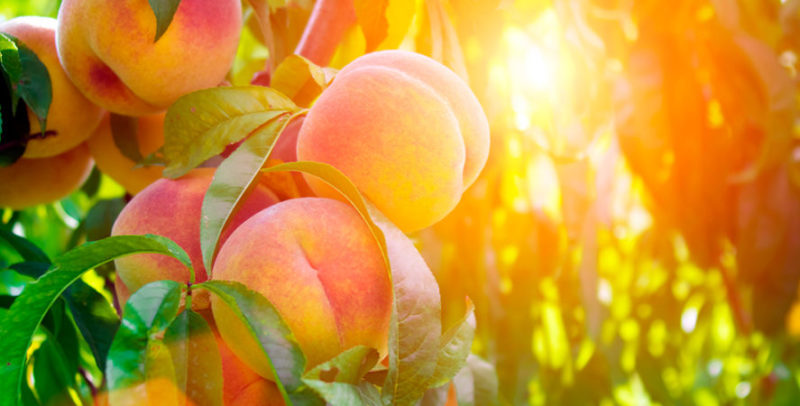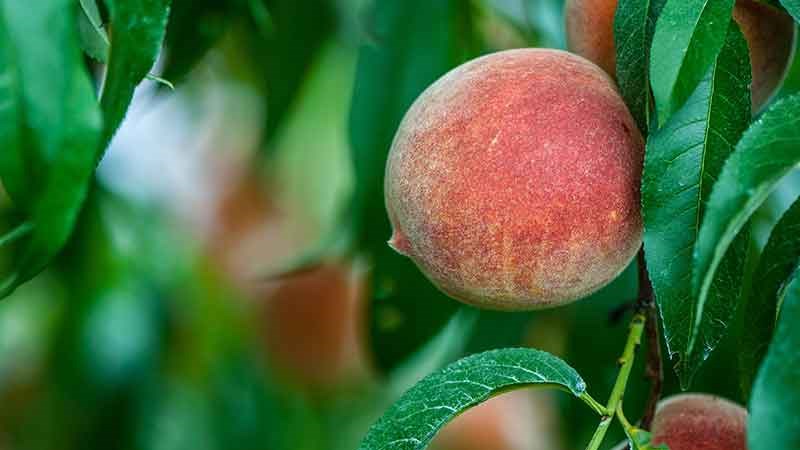How to properly prune peaches in the summer: schemes and procedure
Peach is a capricious culture that requires increased attention and adherence to the rules of agricultural technology. The southern fruit needs proper crown shaping to maintain fruiting and strengthen immunity. In the article we will talk about pruning a peach in the summer, depending on its age and growing region.
The content of the article
Is it possible to cut a peach in summer

Trees get nutrients from the soil... They pass through the trunk and are evenly distributed between the branches. In peach, these processes occur much faster than in other crops.
The tree instantly spends the incoming nutrients on the formation of growing branches. Without regulating pruning, the crown will quickly thicken, and the central branches will become bare and stop bearing fruit. Fruits will begin to tie on the peripheral branches, which will reduce the productivity of the plant.
Regular pruning of improperly growing branches will help prevent the problem. A correctly formed crown improves ventilation, facilitates harvesting, and gives the tree aesthetics.
When to prune a peach in summer
The optimal time for pruning peaches in summer is June 15 - July 15. During this period, seeds are formed in the fruit.
Auspicious days according to the lunar calendar for 2021:
- June - 15, 16, 19-25, 29, 30;
- July - 4-7, 13-15.
Types of trimming

There are several types of peach pruning: shaping, restorative, regulating, rejuvenating.
Formative pruning is performed in the second year after planting and ends in the fifth year of the plant's life. The procedure is carried out in the spring to give the crown the desired shape. To do this, cut off dry and dead branches, regulate the height of the tree and yield, remove excess shoots.
Goals of Anti-aging Summer Pruning:
- removal of dry and weakened branches;
- thinning of non-fruiting shoots;
- cutting branches growing inward;
- shortening of fruitful shoots, abundantly covered with ovaries, so that they do not break under the weight of the fruit.
Restorative haircut is performed in autumn. Its essence lies in preparing the tree for wintering. To do this, remove all dry and diseased branches, shorten the frame and fruitful ones. No more than 80 shoots are left on the tree. Plant residues are collected and burned away from the site.
Regulatory pruning is performed at any time of the year. The procedure is aimed at balancing the growth and fruiting of trees, removing thick shoots that do not produce fruit, and shortening branches with a large number of peaches.
How to prune a tree correctly
Compliance with the rules of haircuts, the use of sharp and sterilized instruments allow you to perform the procedure with minimal losses.
Required materials and tools
To trim a peach tree you will need:
- garden file;
- secateurs;
- garden knife;
- lopper.
Copper sulfate, potassium permanganate solution or medical alcohol are used to disinfect instruments. For the processing of cuts, a garden pitch or a special "Rannet" tool is suitable.
Trimming scheme

The work is carried out according to the following scheme:
- Remove weak and dry branches that draw nutrients from the tree but are not practical.
- Unfertile branches are thinned out.They do it carefully, try not to touch the shoots, abundantly covered with foliage, which, during the active growing season, provide the plant with oxygen and nutrients.
- Shoots growing deeper into the crown are cut to the base, improving the illumination of the plant. This improves the color and flavor of the fruit.
- The branches covered with fruit ovaries are slightly shortened so that they do not break off under the weight of ripe peaches.
Summer pruning of excess branches contributes to the formation of larger and more juicy fruits.
Features of pruning depending on the type of tree
Peach pruning schemes depend on its age and growing region.
Depending on the age of the peach
The scheme of crop pruning at different periods of life:
- In the first year of life, the plant is shortened to 60 cm. Skeletal branches of the 1st tier are formed from lateral shoots, the tips are cut to the third bud.
- In the second year, all shoots are removed, except for 4 skeletal branches of the 1st tier. They are cut below the trunk by 1 level. The cut should be below the outer kidney.
- In the third year, the lower branches of the 2nd tier are formed 50 cm higher than the 1st. The strongest shoots are left, the rest are cut off.
- In the fourth year, the upper branches of the 2nd tier are laid on the back of the lower ones. They are cut to 5–8 buds and thinned out at a distance of 15 cm from each other. The second tier is formed from 5 skeletal branches. All shoots are cut to 1/3 of the length.
- In the fifth year of life, a two-tiered tree with a height of 2.5–3 m is formed. To form a peach in the form of a bush, remove the main trunk and leave 4 lower branches. To create a creeping shape, the main shoot is completely cut off and 2 branches are left. On one of them the harvest ripens, the other is used in case of the death of the first.
In the sixth year of life, the crown of the peach is considered formed. A mature tree needs rejuvenating, regulating and sanitary pruning.
Depending on the region of cultivation
Peach pruning in different regions is carried out to increase resistance to adverse weather conditions. Winter hardiness of the culture directly depends on the method of crown formation.
Reference. For example, a tree formed by a spindlebush - in the form of a spindle, perfectly tolerates the southern winter in Cherkessk and Makhachkala, but in the Krasnodar Territory and in the Kuban it can freeze slightly. Here the peach is formed into a bowl.
In the middle lane, the peach is cut in the form of a tall bush; in more severe climatic conditions, it is laid horizontally - in the stanza.
Further care of the plant

After pruning, the crop needs in careful care... Experienced gardeners recommend using oil paint instead of garden varnish to lubricate the sections, since the wounds from it sometimes begin to rot due to excess moisture. The paint has better sealing properties, it prevents decay more effectively. Paste "RanNet" possesses similar properties.
Before applying the putty, the wounds are dried with a 3% solution of copper sulfate, which is applied with a sponge and left for 1-2 hours. Then putty is applied to the cut.
The complex of mandatory procedures includes:
- weeding;
- loosening the soil in the trunk circle;
- mulching with organic matter (crushed bark, rotted sawdust, cut grass, mature compost).
It is not recommended to use hay as mulch as it becomes a habitat for rodents.
Important! Mulching the trunk circle saves the gardener from routine work - loosening and weeding. Organic matter retains moisture inside the soil and reduces the frequency of watering, provides the peach with nitrogen and carbon dioxide.
In the summer, trees are fertilized with potassium and phosphorus, and nitrogen is forgotten until next spring. For foliar top dressing use the complex remedy "Zdraven AQUA for fruit trees". At the end of August, spraying with "Plantafol" is carried out to stimulate the maturation of wood.
With a shortage of natural precipitation, trees are shed to a depth of 0.5 m. Moistening is stopped 2 weeks before harvesting.In the fall, water-charging irrigation is carried out to prevent the freezing of the root system in winter. The stems are whitewashed with the Gardener lime paste.
In regions with little snowy winters, an additional dry shelter is created from reed or corn huts, agrospan caps.
The first stage of work on sheltering a peach for the winter begins after the leaves fall, before the onset of frost, so that the branches can more easily fit on the ground. To save covering material, the tree is bent as low as possible. Small shoots are connected and tied to the main branch. The procedure is carried out carefully so as not to break the plant. Old branches can be cut off as they are difficult to bend.
To protect the trees from rodents, a repellant is placed in the center of the bush. Additionally, trees are treated with the following compositions:
- a mixture of clay and cow dung with carbolic acid (1 tablespoon per 10 liters of the mixture);
- a mixture of fish oil with naphthalene in a ratio of 8: 1.
The mechanical method of protection involves tying the trunk with special nets, roofing felt, spruce branches. Dense materials are removed during thaw periods to prevent condensation.
It is interesting:
Methods for propagating peach cuttings in summer: instructions and useful tips
Experienced gardening tips

Tips from other gardeners to help keep your peach healthy, support fruiting and increase stress tolerance:
- When pruning a crop, it is important to take into account that fruiting branches grow at an angle of 45 °.
- When shortening the shoots, at least 2 buds are left on each.
- To rejuvenate the tree and restore the lost fertility, all branches over 4 years old are removed.
- After landing no more than 4 lower shoots are left on it, which will later become the basis for the formation of the crown. All other branches are cut off.
- A cupped crown is created during spring pruning.
Conclusion
Summer peach pruning is done as needed. It is not included in the list of mandatory care procedures, but it helps to maintain the health of the tree, prolong its life and increase its yield.
The haircut is performed from June 15 to July 15: weakened, dry and growing branches are removed, the infertile ones are thinned out, the shoots densely covered with fruit ovaries are shortened. After pruning, the trees are fed with potassium and phosphorus, watered when there is a shortage of natural precipitation, they take care of shelter for the winter and protection from rodents.